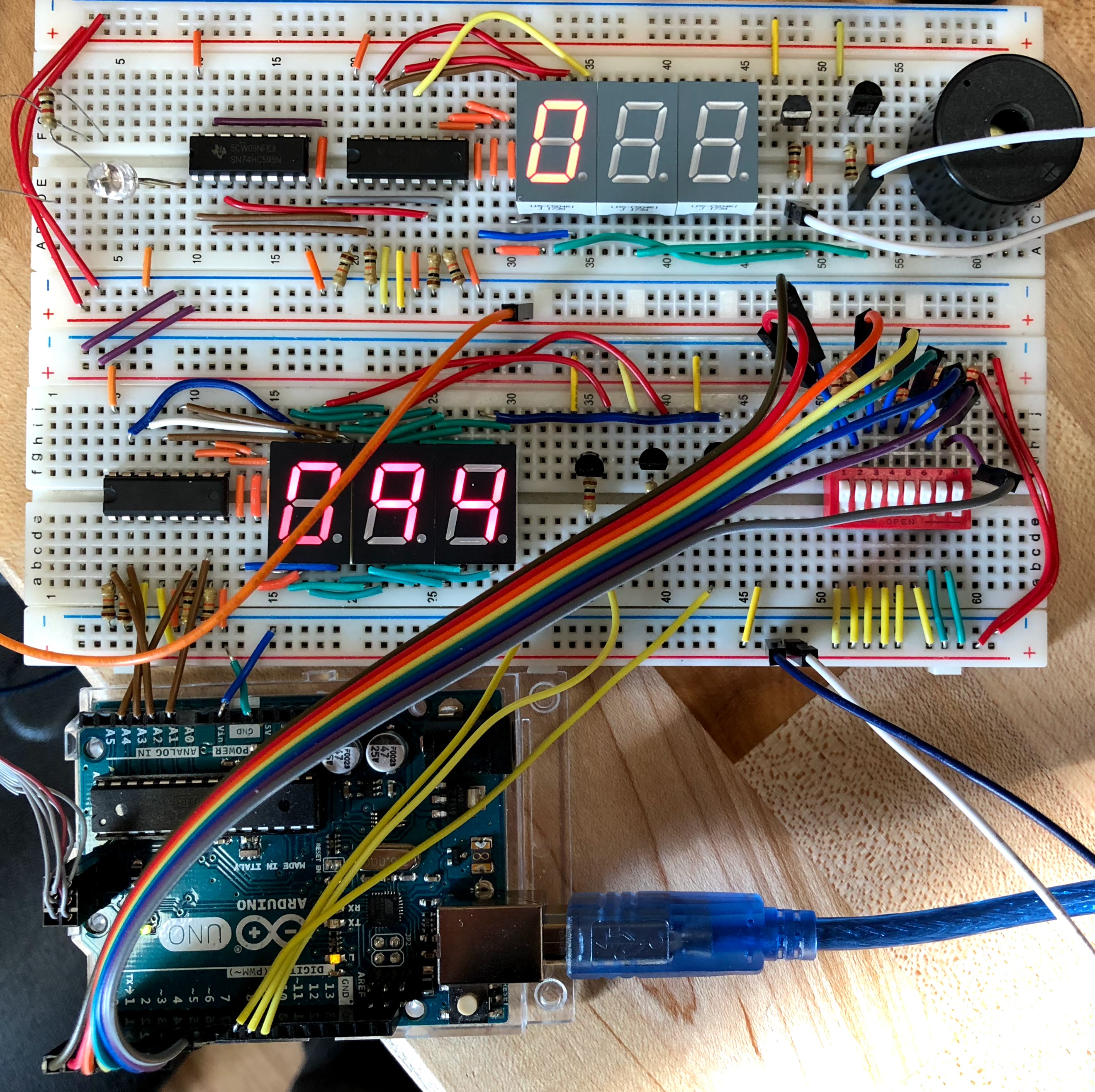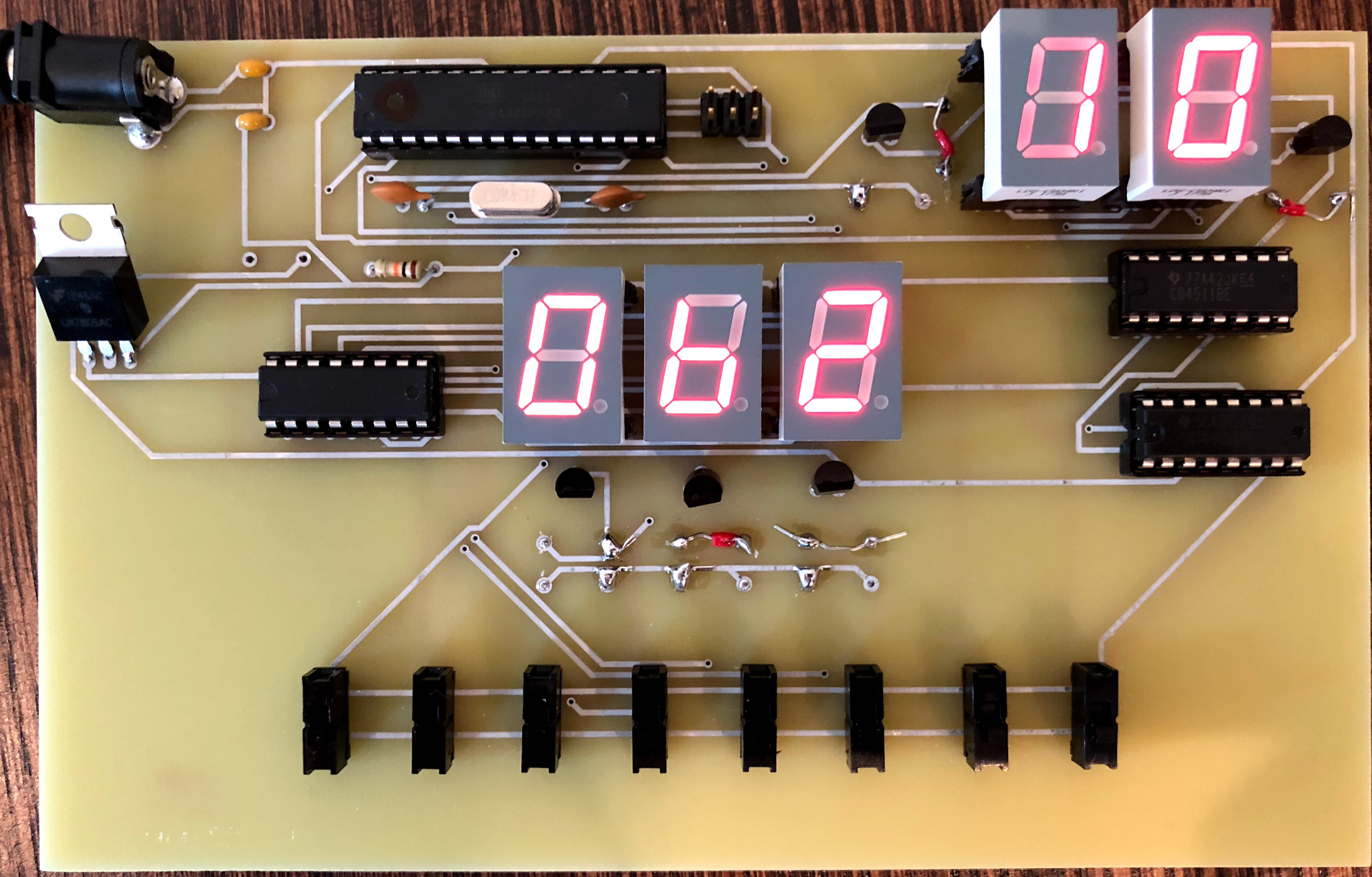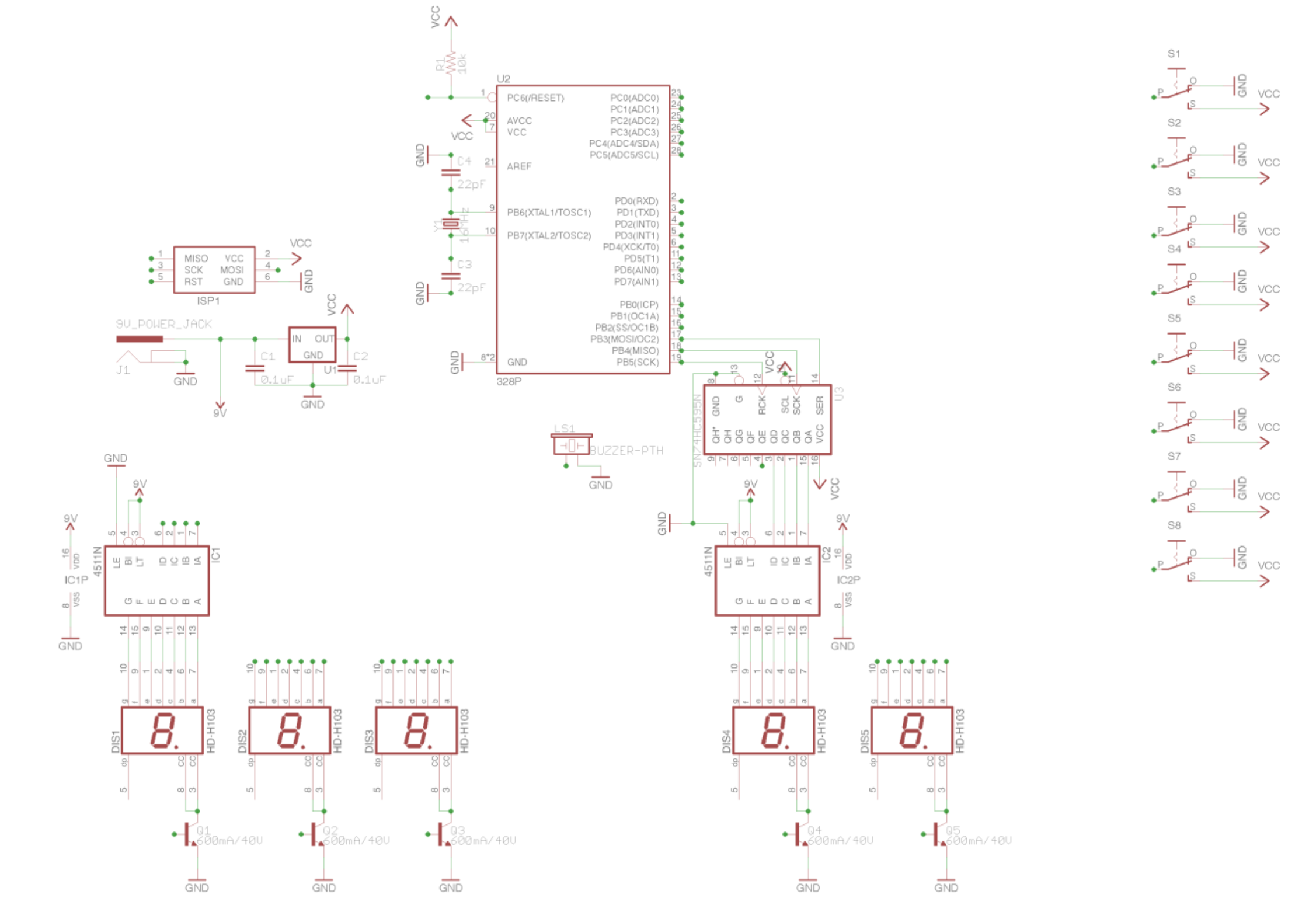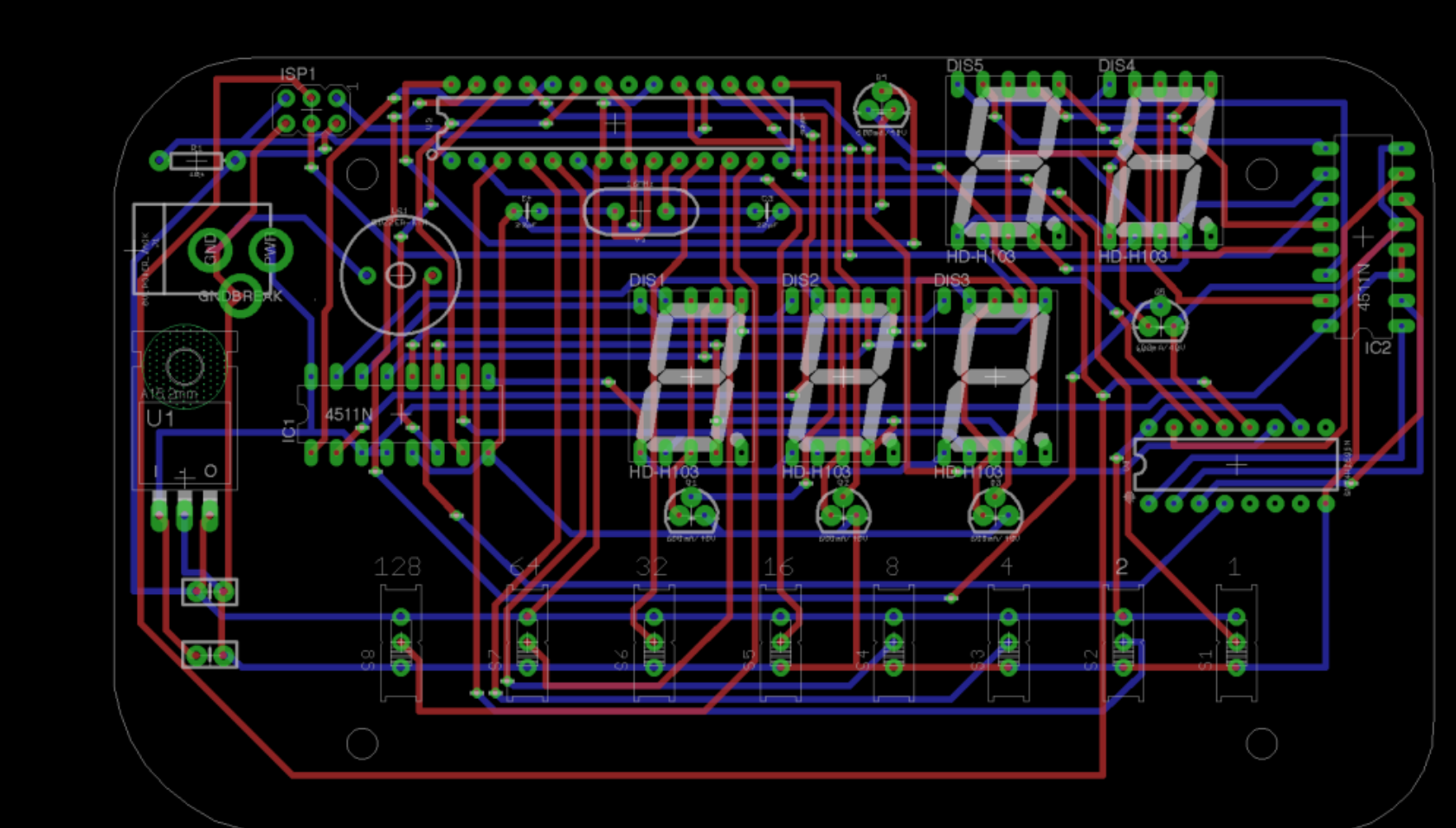
Assembly Binary Game
Purpose
The purpose of the Assembly Binary Game Project (referred to in this report as the “ABG Project”) is to provide a hardware substitute for the now defunct online Cisco Binary Game. The binary challenge was a competition amongst junior ACES where a tournament is held to see who can achieve the highest score in a fixed amount of time. The ABG Project aims to allow students to hold this competition using physical hardware consoles instead of websites like the Cisco Binary Game, which ultimately ended up being placed behind a paywall. The custom PCB allows for many ABG consoles to be created for a potential class set for future ACES students to continue the binary challenge tradition.
| Parts List |
|---|
| 10k Ω Resistor |
| 5 x 3904 BJTs |
| 16 Mhz Crystal Oscillator |
| ATMega328P |
| 2 x 22 pF Capacitors |
| 8 x Switches |
| 5 x 7-Segment Displays |
| 595 Shift Register |
| 2 x 4511 7-Segment Driver |
| 2 x 100 nF Capacitors |
| DC Jack |
| LM7805 Voltage Regulator |
The ABG Project allowed the undersigned to improve both assembly language skills and PCB design skills. As the entire project’s code is written in assembly, the ABG Project serves as a good introduction to writing complex and fully featured programs in assembly language. The PCB was also found to be one of the most complex through hole boards that the undersigned has designed to date, due in part to the large number of components as well as unique and unfamiliar components that were used by the undersigned on the PCB, such as transistors.
Reference
Random Number Generator Example 1
Random Number Generator Example 2
Random Number Generator Example 3
Procedure
The ABG Project consists of 8 switches for binary number input, seven segment displays for score and the 8-bit number to create in binary using the input switches. The displays are driven by two 4511 7-Segment display driver ICs and a 595 shift register, since many of the ATmega328P’s digital pins are already tied to other components such as the input switches.
The construction of the ABG Project is comprised of 3 steps; prototyping, PCB design and programming.
The first and most straightforward step of the ABG Project is the breadboard prototype. First, 3 common-cathode 7 segment displays were connected to the outputs of a single 4511 chip. The cathodes of each display are each wired to one NPN3904 transistor. The base pins of each transistor are connected to PORTB of the Arduino so that a particular display can be selected in code by blocking the path to ground for the other two by leaving their transistor base pins low. The use of transistors allows all 3 displays to be controlled by a single 4511 using POV by switching through the displays showing one digit at a time so quickly that it appears as one number. The input pins of the 4511 are sequentially connected to PORTC. This configuration makes displaying a digit as simple as outputting a value to PORTC. An additional two 7-Segment displays are used to display the player’s score. These two displays are connected to the outputs of another 4511 chip and their cathodes are connected to transistors in the same configuration as the other 3 displays. The only difference in the setup of the score displays is that the inputs of the 4511 are not directly connected to the Arduino, due to a shortage of I/O pins. Instead, the inputs of the 4511 are connected to the first 4 outputs of a 595 shift register, which feeds the lower nibble of the byte shifted out directly to the 4511. The two transistors for selection of a score display are still operated directly by the Arduino connected to PORTC. The final addition to the prototype circuit is an 8-bit DIP switch, which was connected to PORTD of the Arduino sequentially so that the byte inputted by the user could be read with a simple call to the in command.

The second step in the construction of the ABG Project is PCB design. The key differences between the prototype circuit and the final EAGLE schematic is the addition of a 5V voltage regulator so the board can receive power from a 9V battery. The Arduino is also replaced with an off board ATmega328P and the accompanying circuitry, such as an ISP header. Notwithstanding the few modifications to the original prototype circuit, the PCB did not fully function when it arrived. The code was seemingly running properly on the board but the displays appeared very dim. This issue was initially attributed to the small trace width of 8 mil being unable to carry enough current to support the 7-Segment displays. As a result, an identical board with larger traces was ordered but the same issue was encountered. Upon further inspection, it was discovered that the dimness resulted from the 1k Ω resistors connected to the base pins of each transistor and the 470 Ω resistors connected to the cathode of each display. Since the PCB had exposed traces, all the resistors were removed and replaced with extra wire connecting the two traces, which lead to the displays running at their normal brightness. A third iteration of the board was immediately ordered to settle the issue completely, however, it did not arrive in time for the creation of this report.
The final and most difficult step of the ABG Project is writing the code for the binary game in AVR assembly. The assembly code is structured in a similar way to an Arduino program with a setup label which initializes all the I/O pins and interrupts, and a loop label where the bulk of the game code runs. The code utilizes two timer interrupts and an ADC interrupt. An interrupt on TIMER2 is configured to run at a frequency of 63 Hz constantly polling for the correct switch combination matching the number being displayed. This interrupt service routine (ISR) also assists in the POV for the displays by running the double dabble algorithm on the new random value, breaking it into its individual digits to be presented via POV in the loop label. The comparison between switch input and the number on display is done using the in command to load the value of the PIND register into general purpose register and compare to the number shown on the displays using the cp command. The breq command is used to branch to a new label called isEqual if the comparison returned true, which increments the score value and loads a new random number to be shown. The random numbers come from random number generator code found on the website “AVR Freaks”, which has been modified to use a random seed from an ADC reading. The use of the ADC requires two interrupts. A timer interrupt from TIMER0 is used to schedule new ADC readings and another ADC ISR runs when that reading is completed. The ISR is called ADC_Complete, which runs when there is a new reading. The new reading is copied into a general purpose register defined as newValue, which is fed as a seed to the random number generator.

Media
Unfortunately, the demo video only includes the first iteration PCB prototype. The blue prototype had not yet arrived when the video was shot.


The full EAGLE project files and source code can be found on the unsersigned’s GitHub.
Code
.cseg
#include "prescalers.h"
.org 0x0000
rjmp reset
.equ size = 15
.org 0x000E
rjmp TIM2_COMPA
.org 0x002A
rjmp ADC_Complete
.org 0x0020
rjmp TIM0_OVF
.org 0x100
reset:
clr r22
ldi r16, low(RAMEND)
out spl, r16
ldi r16, high(RAMEND)
out sph,r16
movw z,x
.def original = r16 ; value to be pushed through double dabble algorithm
.def onesTens = r17 ; register holding ones and tens output nibbles from double dabble
.def hundreds = r22 ; hundreds output from double dabble
.def working = r24 ; register used to work with data that needs to be preserved
.def addReg = r20 ; holds a value of 3 to be added to other registers in the double dabble process
.def times = r25 ; register holding the number of bit shifts the double dabble algorithm must do before being complete
.def input = r21 ; raw graycode input from rotary encoder
.def newValue = r23 ; where newly generated random numbers will be stored
.def score = r15
.def copy = r14
.equ data = PB3
.equ latch = PB5
.equ clk = PB4
rjmp setup
timers:
//cli ; global interrupt disable
ldi r16, T2ps1024 ; set the prescaler
sts TCCR2B, r16 ; store to appropriate register
ldi r16, 0x02 ; set timer mode 2
sts TCCR2A, r16 ; store
ldi r16, 124 ; set output compare number to get 63hz freq
sts OCR2A, r16 ; store to output compare reg
ldi r16, 1 << OCIE2A ; set timer interrupt enable bit
sts TIMSK2, r16 ; enable the interrupt
ret
ADCInit:
ser r16 ; set all bits in r16
ldi r16, (1 << REFS0) | (1 << ADLAR)
sts ADMUX, r16
; Enable, start dummy conversion, enable timer as trigger, prescaler
ldi r16, (1 << ADEN) | (1 << ADSC) | (1 << ADIE) | (1 << ADPS2) | (1 << ADPS1)
| (1 << ADPS0)
sts ADCSRA, r16
ldi r16, 1 << ADTS2
sts ADCSRB, r16
dummy:
lds r16, ADCSRA
andi r16, 1 << ADIF
breq dummy
ret
ADC_Complete:
lds newValue, ADCH ; grab ADC reading and place in gp reg
reti
T0Init: ; initialize T0 interrupt to schedule ADC conversions
clr r16
out TCCR0A, r16 ; normal mode OC0A/B disconnected
ldi r16, T0ps8 ;
out TCCR0B, r16
ldi r16, 1 << TOIE0 ; Timer interrupt enable
sts TIMSK0, r16 ; output to mask register to
ret
TIM0_OVF:
lds r19, ADCSRA ; start an ADC conversion
sbr r19, 1 << ADSC ; set the required bit
sts ADCSRA, r19
reti
setup:
clr newValue
clr input
clr copy
clr original
clr score
cli
rcall initScoreDisplay
rcall initShiftReg
rcall timers
rcall ADCInit
//rcall T0Init
sei
rjmp loop
random:
mov r18, newValue
clc
rol r19
brcc pc + 2
eor r19, r18
ret
start:
out 0x0A, hundreds ; clear DDRD register using 0 value in hundreds reg
mov r17, newValue ; copy the seed
and r17, r18
ldi r18, 0x43
; generate random # in newValue reg using ADC reading as seed... reference: https://www.avrfreaks.net/forum/i-need-pseudo-random-number-generator-attiny-13
lsr r17
adc r18, r19
lsr r17
adc r18, r19
lsr r17
lsr r17
lsr r17
lsr r17
lsr r17
adc r18, r19
bst r18, 0
bld newValue, 7
lsr newValue
mov original, newValue
mov copy, newValue
ret
.MACRO shiftOut ; MSBFIRST Shiftout
cbi PORTB, latch
; handle shifting data
cbi PORTB, clk
cbi PORTB, data
sbrc @0, 7 ; skip if bit in register passed to macro is cleared
sbi PORTB, data
sbi PORTB, clk
cbi PORTB, clk
cbi PORTB, data
sbrc @0, 6 ; skip if bit in register passed to macro is cleared
sbi PORTB, data
sbi PORTB, clk
cbi PORTB, clk
cbi PORTB, data
sbrc @0, 5 ; skip if bit in register passed to macro is cleared
sbi PORTB, data
sbi PORTB, clk
cbi PORTB, clk
cbi PORTB, data
sbrc @0, 4 ; skip if bit in register passed to macro is cleared
sbi PORTB, data
sbi PORTB, clk
cbi PORTB, clk
cbi PORTB, data
sbrc @0, 3 ; skip if bit in register passed to macro is cleared
sbi PORTB, data
sbi PORTB, clk
cbi PORTB, clk
cbi PORTB, data
sbrc @0, 2 ; skip if bit in register passed to macro is cleared
sbi PORTB, data
sbi PORTB, clk
cbi PORTB, clk
cbi PORTB, data
sbrc @0, 1 ; skip if bit in register passed to macro is cleared
sbi PORTB, data
sbi PORTB, clk
cbi PORTB, clk
cbi PORTB, data
sbrc @0, 0 ; skip if bit in register passed to macro is cleared
sbi PORTB, data
sbi PORTB, clk
sbi PORTB, latch
.ENDMACRO
.MACRO doubleDabble
ldi addReg, 3
ldi times, 8
clr onesTens
clr hundreds
decideStep:
; check if 3 needs to be added to any of the ones tens or hundreds nibbles
checkOnes:
mov working, onesTens
andi working, 0b00001111 ; analyze only the lower nibble where ones value is
cpi working, 5
brsh addThreeOnes
checkTens:
mov working, onesTens
andi working, 0b11110000 ; analyze only the upper nibble where tens value is stored
cpi working, 80
brsh addThreeTens
checkHundreds:
cpi hundreds, 5
brsh addThreeHundreds
; bit shift
shift:
lsl @0
rol onesTens
rol hundreds
dec times
cpi times, 0 ; if the @0 value has been shifted 8 times move to POV section of the code
breq endDabble
rjmp decideStep ; otherwise repeat
addThreeOnes:
add onesTens, addReg
rjmp checkTens
addThreeTens:
swap onesTens
add onesTens, addReg
swap onesTens
rjmp checkHundreds
addThreeHundreds:
add hundreds, addReg
rjmp shift
endDabble:
//ret
.ENDMACRO
.MACRO numDisplaySelect ; MACRO to enable display of choice in number display
cbi PORTB, PB2
cbi PORTB, PB1
cbi PORTB, PB0
sbi PORTB, @0
.ENDMACRO
.MACRO scoreDisplaySelect ; MACRO to enable appropiate score display ones or tens
cbi PORTC, PC4
cbi PORTC, PC5
sbi PORTC, @0
.ENDMACRO
.MACRO numDisplayOut
cbi PORTC, PC0
sbrc @0, 0
sbi PORTC, PC0
cbi PORTC, PC1
sbrc @0, 1
sbi PORTC, PC1
cbi PORTC, PC2
sbrc @0, 2
sbi PORTC, PC2
cbi PORTC, PC3
sbrc @0, 3
sbi PORTC, PC3
.ENDMACRO
display:
rcall initNumDisplay ; set all transistor manipulation pins to output
numDisplaySelect PB2
numDisplayOut hundreds ; display hundreds
rcall delay
; switch to tens display
numDisplaySelect PB1
mov working, onesTens
andi working, 0b11110000
swap working
numDisplayOut working
rcall delay
; switch to ones Display
numDisplaySelect PB0
mov working, onesTens
andi working, 0b00001111
numDisplayOut working
rcall delay ; admire
ret ;
scoreDisplay:
scoreDisplaySelect PC4 ; select ones display
mov r18, score ; retain score value
doubleDabble r18
mov working, onesTens
andi working, 0b00001111
shiftOut working
rcall delay
scoreDisplaySelect PC5 ; select tens display
mov working, onesTens
andi working, 0b11110000
swap working
shiftOut working
mov r18, copy
doubleDabble r18
ret
delay: ; 1 ms delay
ldi r18, 11
ldi r19, 99
L1: dec r19
brne L1
dec r18
brne L1
ret
TIM2_COMPA:
in input, PIND
cp input, copy
breq isEqual
reti
loop:
rcall display ; display POV for challenge number and score
rcall scoreDisplay
rjmp loop
isEqual:
inc score
rcall start
doubleDabble original
reti
initShiftReg:
sbi DDRB, PB3
sbi DDRB, PB4
sbi DDRB, PB5
ldi original, 0
shiftOut original
ret
initScoreDisplay:
sbi DDRC, PC4
sbi DDRC, PC5
ret
initNumDisplay:
sbi DDRB, PB0
sbi DDRB, PB1
sbi DDRB, PB2
sbi DDRC, PC0
sbi DDRC, PC1
sbi DDRC, PC2
sbi DDRC, PC3
retConclusion
Overall, the ABG Project serves as a fun conclusion to three inspiring years in the ACES program. The project is the culmination of many invaluable skills taught in this course, particularly programming and CAD design. It is also the undersigned’s hope that this project will leave a legacy for future ACES students who wish to take on the binary challenge.